AUSCHWITZ
Not Long Ago. Not Far Away.
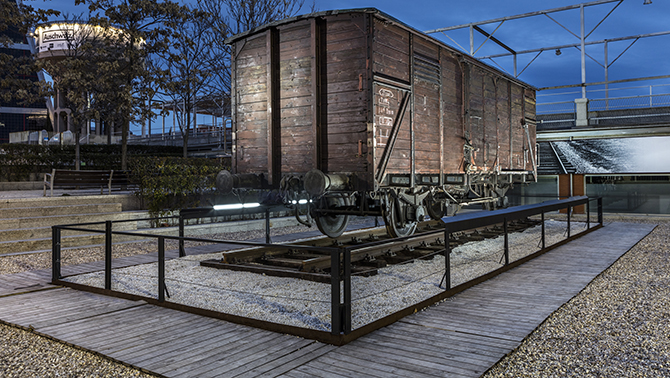
By Ruth J. Katz
Just outside the haimish, second-floor bistro aptly named LOX at Café Bergson, in the inner reaches of the Museum of Jewish Heritage—a Living Memorial to the Holocaust, is a welcoming terrace with a picturesque view of the city’s harbor, framed in verdant foliage. Central in this vista is the majestic Statue of Liberty. It is suggestively appropriate that our celebrated symbol of welcome is visible here, just as she was a beacon to the hundreds of thousands of immigrants who braved transatlantic crossings over the years; Lady Liberty was, assuredly, an uplifting symbol of freedom and hope. It is all the more significant to see her presence, because outside the Museum, in front, is a disturbing site—the antithesis of freedom and hope: an original German-made Model 2 freight train car, the type used for the deportation of Jews to the ghettos and extermination camps in occupied Poland. Indeed, there is no hope here, only spine-chilling forebodings of what the ultimate destination will hold—the horrific finality of this boxcar’s fatal journey.
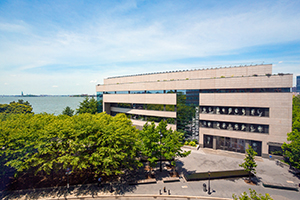 Museum of Jewish Heritage
Museum of Jewish Heritage This ever-potent symbol outside the Museum sets the sober and somber tone for what the viewer will encounter inside, in the 20 galleries—encompassing 18,000 square feet of exhibition space—that comprise the powerful show, Auschwitz. Not long ago. Not far away. Currently on view (through January 3, 2020), the exhibit offers up some 700 original objects never before seen in North America, in addition to 400 photographs, video testimony from survivors, and countless other artifacts, including a section of barracks from the infamous camp as well as concrete posts that formed a part of the perimeter fence.
THE HATRED UNFOLDS
The show is the most comprehensive Holocaust exhibition about Auschwitz ever exhibited in North America. The Museum of Jewish Heritage produced the show in partnership with the Spain-based, international exhibition firm Musealia and the Auschwitz-Birkenau State Museum in Poland. Originally on view in Spain at Madrid’s Arte Canal Exhibition Centre (where it drew record-breaking crowds), the exhibition explores how this human barbarity was able (dare I say allowed?) to incubate: Almost as if in slow motion, the deliberate fostering of hatred unfolds with measured contagion, accented by staccato salvos; it builds to a crescendo, as viewers see how the ultimate formation of the Final Solution was methodically choreographed.
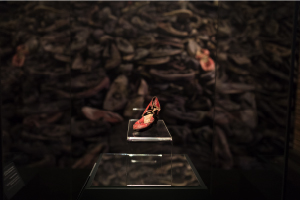 Woman’s Dress Shoe This red dress shoe belonged to an unknown deportee. Collection of the Auschwitz-Birkenau State Museum, Oświęcim, Poland. ©Musealia
Woman’s Dress Shoe This red dress shoe belonged to an unknown deportee. Collection of the Auschwitz-Birkenau State Museum, Oświęcim, Poland. ©MusealiaComments Luis Ferreiro, director of Musealia and the exhibition project, “Auschwitz did not start with the gas chambers. Hatred does not happen overnight: it builds up slowly among people. It does so with words and thoughts, with small everyday acts, with prejudices.” The show chronicles these subtle occurrences and allows us to understand how this structured annihilation flourished. Ferreiro describes his firm’s mandate, noting, “When we had the vision to create the exhibition, we conceived its narrative as an opportunity to better understand how such a place could come to exist, and as a warning of where hatred can take us to.”
Curated by an international team of experts, spearheaded by chief curator Dr. Robert Jan van Pelt, a leading expert on Auschwitz, the show represents the first time since the liberation of the camp that a traveling exhibition dedicated to the historical significance of Auschwitz is being presented to an American audience. Fittingly, the exhibition’s May 8th opening coincided with the anniversary of Victory in Europe Day, 1945, when the Allies celebrated Nazi Germany’s surrender and the end of World War II in Europe.
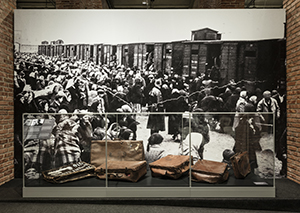 Suitcases confiscated from deportees to Auschwitz; in the background is a photograph of hostages arriving at the camp. Exhibition installation, Centro de Exposiciones Arte Canal, Madrid, 2017. ©Musealia
Suitcases confiscated from deportees to Auschwitz; in the background is a photograph of hostages arriving at the camp. Exhibition installation, Centro de Exposiciones Arte Canal, Madrid, 2017. ©MusealiaExhibition objects are primarily from the Auschwitz-Birkenau State Museum, but there are also many items from more than 20 international museums and institutions, including hundreds of personal items—nearly 100 are rare artifacts from the Museum’s collection, many of which reflect the experiences of survivors and liberators who ultimately found refuge in the Greater Metropolitan Area. Among those items are suitcases, eyeglasses, and shoes; having viewed virtual mountains of these kinds of goods—the lares and penates of daily life—in glass vitrines at Auschwitz itself, I found these symbolic personal possessions simply heartbreaking: Here, one small vitrine holds less than ten suitcases, including two simple wicker baskets and one beaten-up leather valise bearing the name, if I read it correctly, “Dr. Stein.” It will readily bring you to tears, as you ponder the upheaval and mayhem brought to Dr. Stein’s life…and likely, ultimate death.
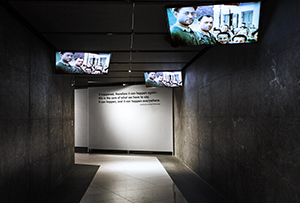 Exhibition Entrance Visitors enter through a hallway showing a video of life before the Holocaust. Displayed at the end of the entrance hall is a quote from Auschwitz survivor Primo Levi: “It happened, therefore it can happen again: this is the core of what we have to say. It can happen, and it can happen everywhere.” Museum of Jewish Heritage / John Halpern
Exhibition Entrance Visitors enter through a hallway showing a video of life before the Holocaust. Displayed at the end of the entrance hall is a quote from Auschwitz survivor Primo Levi: “It happened, therefore it can happen again: this is the core of what we have to say. It can happen, and it can happen everywhere.” Museum of Jewish Heritage / John HalpernHOPE FOR THE FUTURE
“Seventy-three years ago, after the world saw the haunting pictures from Auschwitz, no one in their right mind wanted to be associated with Nazis. But today, 73 years and three generations later, people have forgotten, or they never knew,” observed Ron Lauder, the founder and chairman of the Auschwitz-Birkenau Foundation Committee and president of the World Jewish Congress. “This exhibit reminds them, in the starkest ways, where anti-Semitism can ultimately lead, and the world should never go there again. The title of this exhibit is so appropriate because this was not so long ago, and not so far away.”
For more information on the Museum of Jewish Heritage-A Living Memorial to the Holocaust, visit auschwitz.nyc.
© 2019 Ruth J. Katz All Rights Reserved




